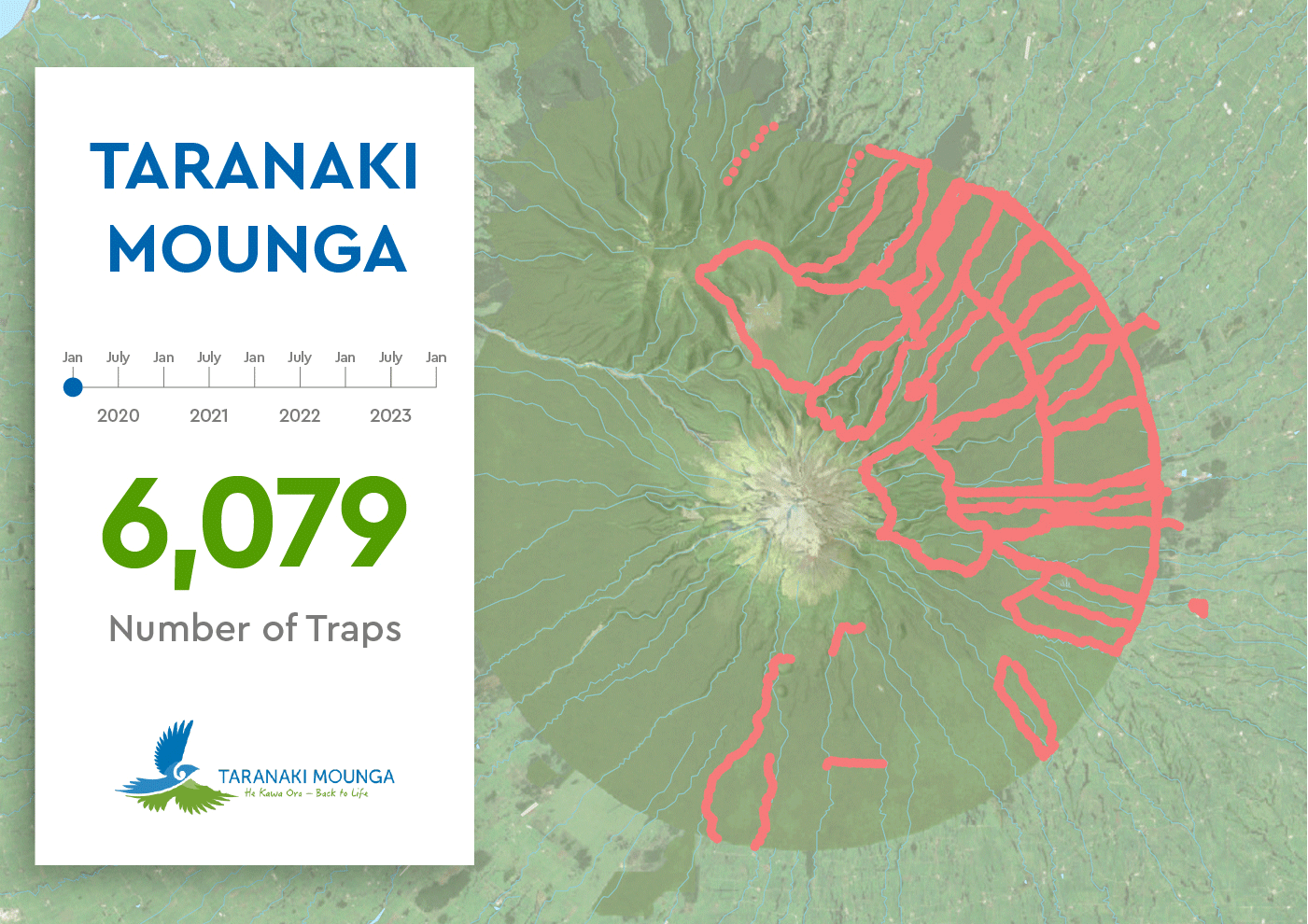Taranaki Mounga Project
Annual Report 2022-23
Table of Contents
Overview
Taranaki Mounga is an ambitious landscape restoration project partnering with iwi of Taranaki, the Department of Conservation, funders and the community to get rid of predators and pests from the mountain, ranges and islands of Taranaki.
Now in its 7th year, the project aims to transform the ecological resilience of the area involved to reflect the importance of Taranaki Maunga long into the future, and uplift and improve the wellbeing of the communities around it.
Taranaki Mounga Project is also funded by the Next Foundation and Toi Foundation. Founding sponsors included Shell New Zealand, Jasmine Social Investments and Manaaki Whenua – Landcare Research.
Vision
He Kawa Ora: Sustaining the health and wellbeing of Te Kāhui Tupua and their people.
Restoring the ecological vitality of Taranaki Mounga in partnership with iwi, agencies and community.
Outcomes: The ecological resilience of Taranaki Maunga is restored. Supported by local and regional government, Taranaki iwi chairs and the community, embrace and sustain the transformation of Taranaki Mounga to an ecologically resilient state.
Chairperson’s report
Taranaki Mounga Project has achieved milestones and made steady progress on our goals in the 2022-23 financial year. It’s been a year of consolidation, working out what is working best to eradicate predators, and finding our bearings following the global pandemic. Covid continued to impact our families and disrupt our mahi last year. However, some of the lessons in the last few years of slowing down and individuals and communities connecting more with nature appear to be holding fast.
Our partnerships have grown stronger this past year, from a maturity in the way we work with funders, to suppressing predators in a targeted manner working collaboratively with a range of organisations. More and more we are seeing the community coming on board as we achieve gains in biodiversity.
We continue to work towards the Tomorrow Accord goals, our agreement with the Department of Conservation and the Next Foundation. Eradicating Goats from Te Papakura o Taranaki in 2021-22 was the first milestone achieved in the Accord, and we’re seeing those benefits already with more native undergrowth and a flourishing of native habitats. We’ve made steady progress this year on other Tomorrow Accord goals; controlling mustelids to enable the growth of whio and kiwi, and eliminating rats from Ngā Motu.
Financially we are in a good position, as many of our initial goals, set within a 20-year time frame, have been completed early and therefore cost less. We’ve directed those savings into predator control efforts, in particular targeting rats and stoats.
We’ve grown as a board, constantly reflecting on how we are doing things and ensuring we are upholding our values. We updated our strategy last year, which ensures the focus is on our collective vision, shifting away from a species by species approach, and ensuring the way we measure things is holistic and include intangibles like relationships.
We’ve also had some changes with our trustees. We’ve welcomed Jan Hania, Stephen Hall and Henry Weston as Trustees, who bring a rich kete of experience, and we’ve farewelled Devon McLean and Ngaire Best, who have moved on after several years. A huge mihi to them for their service.
We would like to thank all our funders and helpers for their support. We look forward to continuing the mammoth task of restoring Taranaki Maunga and Te Papakura o Taranaki in the coming year.
Jamie Tuuta, Chair

Taranaki Mounga Project Independent Chair
Jamie Tuuta
Operational Report
On the operational front a major change has been welcoming Ngahina Capper on board in April 2023, filling the newly-created role of Operations Manager. Ngahina’s role supports changes that the Taranaki Maunga settlement between iwi of Taranaki and the Crown will bring, including increased collaboration.
One of the foundation operational principles of the project has been to support individuals and entities with expertise in particular areas to deliver for their mountain, rather than to duplicate effort. In this way Te Kāhui Tupua benefit from the expertise and passion of many. Successes in Kiwi (where Taranaki Kiwi Trust have been working to restore this species for several decades), and on Kaitake are great examples of this.
We’ve celebrated the successes of our rangers and apprentices, who have completed their Level 3 certificate in Pest Operations this year and are continuing with their Level 4 studies at Te Pūkenga. Our first apprentice has graduated and others are close to completing their apprenticeships. We look forward to supporting them as they grow into leaders, many of whom are on a journey of connecting with the whenua and revitalising te reo Māori.
Volunteers have taken care of a steadily increasing area in the past year, with 70 percent of the mustelid trap network now maintained by volunteers, an increase of 10% on the previous year. Planning is underway for more to come on board, particularly on the southern side, as trap-lines tracks are developed and made safe for helpers. We’re expecting a large intake of new volunteers, given we had 60 people sign up following media coverage calling for volunteers and highlighting the increase of whio in Te Papakura o Taranaki.
Predator control work on Kaitake has exceeded everyone’s expectations with the almost total elimination of possums thanks to cameras, smart trapping technology, clever dogs and hundreds of committed helpers working trap-lines. Meanwhile, we’ve consolidated our mustelid trapping network and have started planning for implementing intensive rat control on part of Kaitake. We’ve also started actively controlling feral cats across 2,800ha. Planning was undertaken for aerial 1080 operations across Te Papakura o Taranaki, which was delayed due to weather conditions. 1080 continues to be an important part of our toolbox in supressing predators.
The ongoing hard work of trapping is helping native species to flourish. Whio numbers continue to improve and be self-sustaining, despite a tricky season for monitoring them due to lots of rain. Released kiwi are breeding on their own, and this season (2023) 21 kiwi were released on Taranaki Maunga. A low for the year was the devastating loss of 3 monitored kiwi on Kaitake in August 2022. However, working collaboratively across organisations trapping efforts were promptly redoubled to identify and catch the offending ferret/s or feral cat.
We continue to enjoy our strong embedded relationship with DOC, the envy of many around the country, and are thankful for all our staff, volunteers and helpers across the restoration sector who are contributing and committed to restoring Taranaki Maunga so we can treasure him for generations to come.

Pou Whakahaere Taurua / Co-Project Manager
Sean Zieltjes

Pou Whakahaere Taurua / Co-Project Manager
Sera Gibson
Thank you to our partners,
funders and supporters.
We cannot achieve our vision without the support of all of our partners.
To our funders – you are the best for believing us, letting us get on with the job, and sharing our successes and challenges.
To iwi, delivery partners and agencies– it’s great working with you. We achieve so much more together. We value our relationships, which are interwoven across the Taranaki restoration sector.
To our large community of volunteers, including individuals, hapū, schools and non-profit groups -You are awesome, and the mahi you do for our environment will be felt for generations to come.
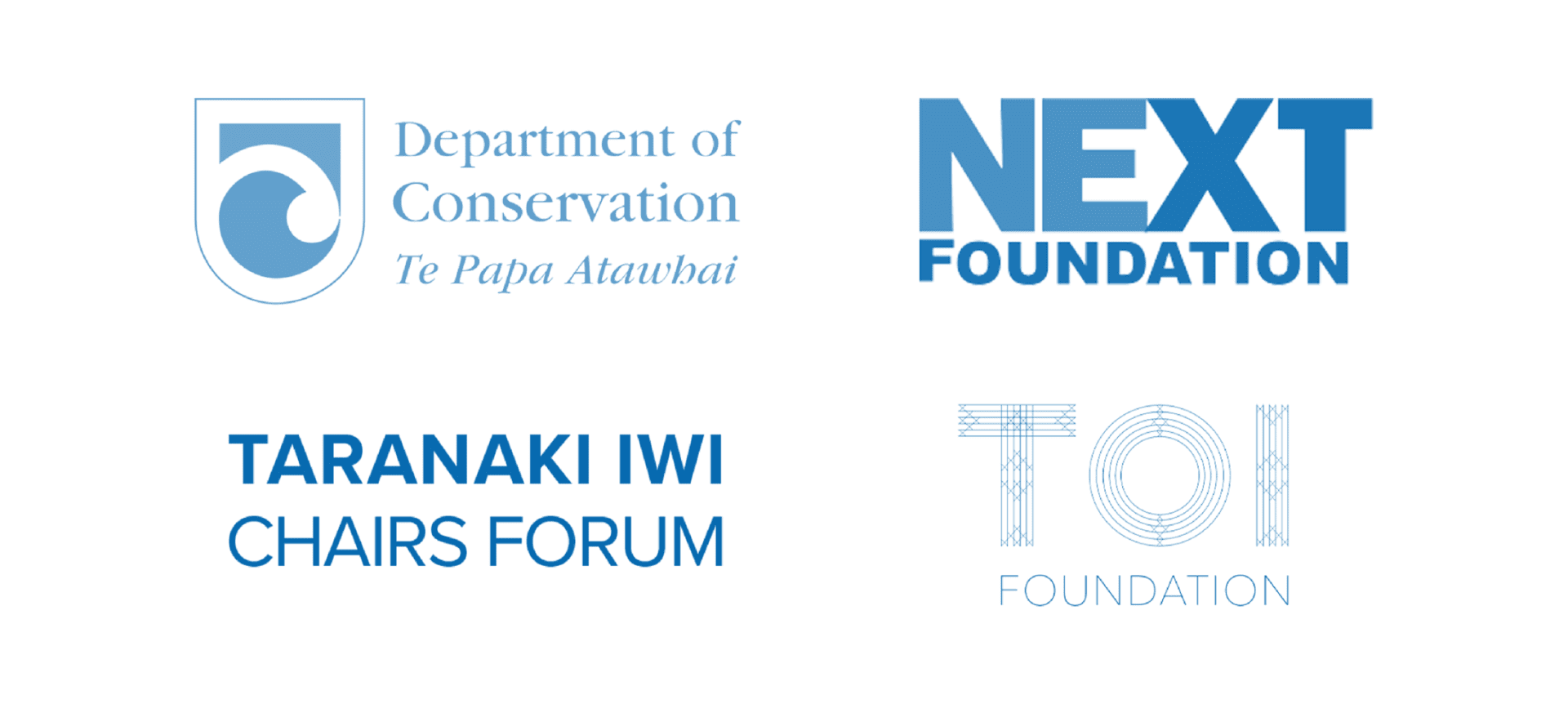
Sean Zieltjes / Next Foundation Acknowledgement
Sera Gibson / Toi Foundation Acknowledgement
“Te Papa Atawhai/DOC is proud to be working in close partnership with Taranaki Mounga Project (TMP) to continue the protection of important biodiversity values on the Maunga. The partnership continues to deliver positive results for threatened and protected species within Te Papakura o Taranaki (the National Park). This year’s release of more kiwi on the Kaitake Range and Maunga for example, reflects the result of ongoing hard work, planning, and close collaboration between not only Te Papa Atawhai/DOC and TMP, but also Iwi and the wider community. I think it’s also important to recognise the value of this project in enabling so many people to connect and participate in the restoration of Taranaki Maunga, strengthening relationships between people and place.”
— Gareth Hopkins, Operations Manager Taranaki
Locations of Monitored Kiwi on Taranaki Maunga and Kaitake
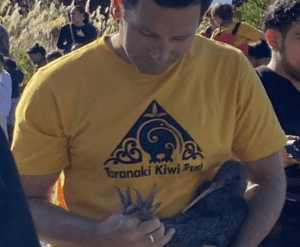
Stronger Together
We’re proud of our strong working relationships across multiple organisations helping kiwi to thrive on Taranaki Maunga, working with Taranaki Kiwi Trust, Rotokare Sanctuary (including Taranaki Kiwi Kōhanga at Rotokare) Te Ara Taiao and East Taranaki Environment Trust. It’s no simple undertaking working across multiple organisations involving complex logistics and kiwi that like to do their own thing. We’re guided in our relationship by our values Mana Motuhake/ Authority, Te Tirohangaroa/ Forward Looking, Manaakitanga/ Reciprocity and Kotahitanga / Collaboration. Those values essentially mean we’re committed to working together in a spirit of generosity, care and respect, without duplicating efforts so we can achieve a bold transformational shift in the Taranaki taiao. Staff and volunteers also get on with the job helped by being professional, having genuine respect for each
— Tane Manu, Kaiwhakahaere (Regional Manager) for Te Ara Taiao
Outcome Strategy
—
1. Aspire
Iwi and communities are leading and owning the successful restoration of Te Kāhui Tupua
2. Share
The innovative practices adopted for Te Kāhui Tupua inspires future NZ large-scale restoration projects
3. Enrich
The people of Taranaki have the ability to self-sustain Te Kāhui Tupua now and in the future
4. Revitalise
Improving the ecological resilience of Te Kāhui Tupua so that native species flourish
5. Treasure
People adore Te Kāhui Tupua not only for his health and wellbeing benefits, but for a sense of regional identity and belonging
Aspire
We’ve been increasingly celebrating and embedding tikanga in the release of kiwi in Te Papakura o Taranaki. Working closely with our partners, we have involved a wide range of people and groups across a series of releases. We’re supporting Te Ara Taiao to engage with schools, getting tamariki from schools around the maunga to be part of monitoring, trapping and learning about kiwi and other species. For the first time we held a kiwi release ceremony fully in te reo Māori, which enabled kura kaupapa from Taranaki to attend, as well as extend our kaimahi on their te reo learning journey.
As well as receiving native species, we’ve also been involved in sharing flourishing species to hapū and sanctuaries where plants and animals have disappeared. In April 2023, 60 Titipounamu were caught on Taranaki Mounga and released to Tarapuruhi, a predator-free sanctuary near Whanganui. Puketapu, Pukerangiora and Ngāti Tawhirikura hapū gifted the birds to Ngaa Rauru Kiitahi. Aunty Kura Niwa, who led the process with Hoani Eriwata, said: “A decade ago we would never have thought we’d be leading a process of taurima for manu, so we are thrilled our titipounamu population is doing so well that we are able to undertake this tikanga.”
Many wānanga were also held this year to support iwi and communities leading the restoration of Te Kāhui Tupua and grow our collective knowledge about species and processes. Some we’ve hosted and others we’ve taken part in, including:
- Te Wānanga Whakamātaki – Māori Biosecurity Symposium
- Ngā Motu Whānui Manumoana – seabird drone monitoring
- eDNA
- Whio monitoring and translocation
- Water testing
- Kiwi restoration
- Te Pua o te Reinga
- Te Reo Taiao
- Trapping workshops
- Leadership workshops
- Seabird restoration
- He Kura Taiao
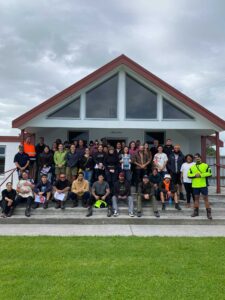
Plant Wānanga
In April 2023 Taranaki Mounga Project organised a wānanga at Puniho Pā to discuss the beautiful, mysterious and once-abundant plant, Pua o te Rēinga, which lives off a host tree’s roots and is pollinated mostly by pekapeka tou-poto (short-tailed bat). While the weather didn’t work out for a hīkoi to see this key-stone taonga species found on Taranaki Maunga, there was plenty of kōrero, sharing experiences and knowledge. Much was gained in relationships, species translocation processes, community engagement and mātauranga Māori. Some seeds were shared and conversations are continuing across iwi, hapū, Zealandia, Ōtari Botanic Gardens, DOC and our team about how we can restore and enhance Pua o te Rēinga (also known as Dactylanthus taylorii and wood rose) to
Aunty Kura releasing titipounamu
Share
We’ve been adept at trialling new technologies and collaborating on research on Taranaki Maunga since the project started. True innovation isn’t easy, and new traps and methods don’t always work, although we always learn something. Progress can feel incremental; our rangers are constantly assessing the equipment and methods, and checking if our tactical focus across multiple predators is working. We’re at the early stage of sharing our findings publicly, although we discuss them at restoration forums and in wānanga.
In the past year our collaboration with Manaaki Whenua provided insights for our evolving predator control, including using DNA to understand possum home range and mustelid control, as well as species restoration of Toutouwai. Doctoral student Theo O’Malley has also contributed with her research and we’ve gained new insights into our methods on Kaitake.
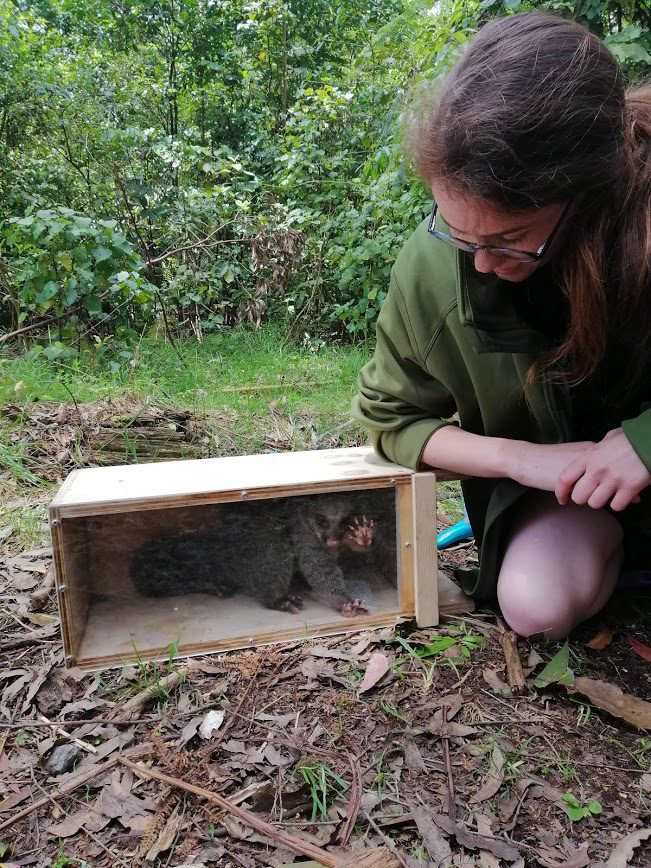
Possum behaviour helps inform predator trapping
Research into possum behaviour is helping inform predator control work on Taranaki Maunga.
Theo O’Malley’s research for her PhD – carried out between 2018 and 2021 and submitted last year, investigated predator behaviour, including the home range of possums and their interactions with different types of traps.
Theo found possums have a large variation in their home range, some ranging from 10 hectares while others were roaming up to 100 hectares. While the findings raise more questions, it’s helped predator control work, such as working out the minimum spacing of traps that works best for catching possums in areas where numbers of possums are low.
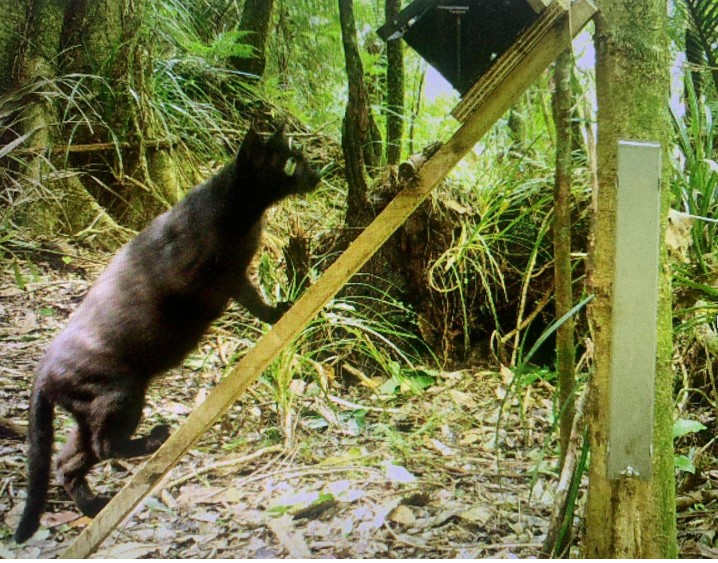
Caught on Camera
A network of cameras across Kaitake is identifying predator hotspots and showing how control methods are working.
Since April 2021 63 trail cameras have been capturing images of animals on Kaitake. The cameras are strapped to trees by traps and automatic lures. Every two months, the camera memory cards are collected by rangers and the data is analysed by an app.
Biodiversity Ranger Katherine Turton is examining the camera network for her Masters in Pest Management at Lincoln University.
She said stoats, possums, cats, hedgehogs, rats, mice and occasionally dogs have shown on the cameras. Kiwis are also spotted, and the information shared with the Taranaki Kiwi
Enrich
The people of Taranaki have the ability to self-sustain Te Kāhui Tupua now and in the future.
Our aim is to ensure Te Kāhui Tupua is sustained by the people of Taranaki now and well into the future. To do that we need a capable workforce, supportive communities and volunteers, businesses on board and making sure we maintain our social license.
This year we’ve been working on developing our leadership and capability with those who work at Taranaki Mounga Project. Our rangers and apprentices have been upskilling, completing their L3 certificates in Pest Management and continuing with the next level. We celebrated the milestone of our first apprentice Tipunakore Rangiwai graduating and his continuing career as a ranger with Te Kahui o Taranaki. Other apprentices will be graduating later in 2023 and 2024. Our team is on a Te Reo Māori journey, led by Te Ingo Ngaia, who is helping with mentoring and teaching. This programme is supported by the New Zealand Biological Heritage National Science Challenge.
Volunteers are vital to the restoration of Taranaki Maunga and it’s heartening to see more getting involved. This year 70% of the mustelid trap network is maintained by volunteers, an increase of 10% over the previous year. We have 22 volunteers checking traps on the stoat trap network from Pouakai to Pembroke Road.
There are also other groups helping out with trap lines including Tawhirikura hapū, Te Kāhui o Taranaki, Taranaki Kiwi Trust and WITT Te Pūkenga. Volunteers also help out in other areas such as Toutouwai monitoring, track clearing and being hut wardens.
Added to those efforts Kaitake Range Conservation Trust have a great team of volunteers with 128 members on their TrapNZ site and 769 traps that are checked fortnightly. They checked 12,272 traps and rebaited, catching 2,094 predators as well as monitored released kiwi to help build a picture of feeding patterns, activity levels and whether kiwi are nesting.
With the expansion of the trapping network on the southern side of the Maunga a call out for volunteers through the media received a great response. More than 60 people have signed up to helping out and we look forward to nurturing new volunteers.
We maintain our social licence by being open and transparent with the public and involving communities as much as possible. It’s important we engage and are upfront on sensitive topics, such as the use of 1080 poison, which continues to be an important tool in suppressing predators in Te Papakura o Taranaki.
Businesses on board tackling pest control
In November last year a tourist venture joined forces with a Taranaki environment group to tackle pest control in the of the region’s more isolated spots.
Forgotten World Adventures, which runs converted golf carts along the former Stratford-Okahukura line, collaborated with the East Taranaki environment Collective (ETEC) to set up 69 pest traps along a 10km stretch of rail snaking through rugged hill country at Te Wera, 35km east of Stratford.
Representatives from ETEC, Taranaki Kiwi Trust, Forgotten World Adventures and Tarananaki Mounga Project placed traps along the rail line, at 150m intervals, from Mohakau Road to the tunnel under Pohokura Saddle.
The rail line runs along the southern boundary of ETEC’s pest management area, which now covers more than 18,000 hectares from Okoki to Te Wera.
Revitilise
Improving the ecological resilience of Te Kāhui Tupua so that native species flourish.
Our predator control programmes cover possums, rats, stoats, ferrets, cats and goats. This year a large amount of work went into tidying up the mustelid network to improve the trap network coverage on the Western side of Taranaki Maunga from Stony River across Pouakai. Although the area of territory trapped didn’t increase, we added DOC 250 traps to catch ferrets and ensure there were no gaps.
The Te Korowai o Ngāruahine TMP team on the southern side of the mountain done a fantastic job in extending the trap network, spaced on average 7km apart, and making safe trails for when volunteers come on board to help with trapping.
On Kaitake it’s been a massive collective effort to eliminate possums and ensure they don’t come back. Specially-trained dogs have been used to track down the last remaining possums -less than a handful – by finding their skat. (link to camera Kaitake story) We’ve been able to verify our possum trapping is working though our camera network and capturing the age and sex of possums we’ve caught. In the last year we’ve had a drop-off in female possums and by the end of the financial year we were mainly capturing juvenile males, showing the population has collapsed. Our next challenge is to prevent the incursion of possums coming in from other areas.
The 34,000 hectare project area now has 7504 traps.
| Output Measures | 2022 | 2023 | Comments |
|---|---|---|---|
| Area free from goats | 34,000ha | 34,000ha | Goat freedom has been maintained. |
| Area under possum elimination work | 2,800ha | 2,800ha | The possum elimination programme is on-going |
| Area under intensive rat control | 1,000ha | 1,250ha | Intensive rat control was increased by 250ha in 2023 |
| Area under active stoat and ferret control | 20,000ha | 22,000ha | The area under active stoat control was increased by 2000ha. |
| Area under active cat control | 2,800ha | Active cat control was introduced in 2023. | |
| Kiwi released into active stoat and ferret control areas | 20 | 21 | Another 21 kiwi were released in 2023. |
These activities are allowing species and native vegetation flourish. We are currently working on three native bird restoration programmes; Whio, kiwi and toutouwai, as well as organised the translocation of titipounamu to a new home at Tarapuruhi, a predator-free sanctuary near Whanganui.
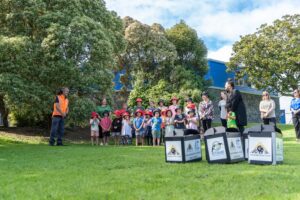
Sharing our Stories
Taranaki Mounga Project is out and about sharing our stories. There’s been at least a dozen stories in the news media across multiple regional and national media organisations in the past year; The Taranaki Daily News, Radio New Zealand, TVNZ, Te Karere, Te Korimako and the Stratford Press. The stories have covered apprentices under DOC’s Jobs for Nature scheme, kiwi releases, calls for volunteers, appointment of new staff, working conservation dogs, translocations of species, 1080, and birds like the population of whio on the mountain doing well.
Our education and promotional efforts help explain what we are doing and why, raising awareness of the importance of
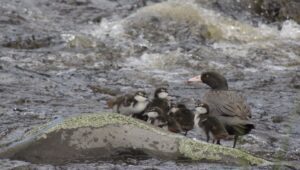
Thriving Whio
While 2022-23 was a tricky summer for monitoring whio, the population on the mounga is stable and there are increasing reports of the elusive native blue ducks beyond the park boundary.
DOC senior ranger Joe Carson says lots of rain and high rivers last summer made accessing and surveying this taonga species across 10 rivers on Mt Taranaki more of a challenge.
Current estimates are of 50-60 pairs of whio, regarded as a self-sustaining population. Two years ago a record 78 duckling whio were counted. It’s thanks to a big team effort between Te Korowai o Ngāruahine Trust, DOC and TMP in creating a network of 1100
